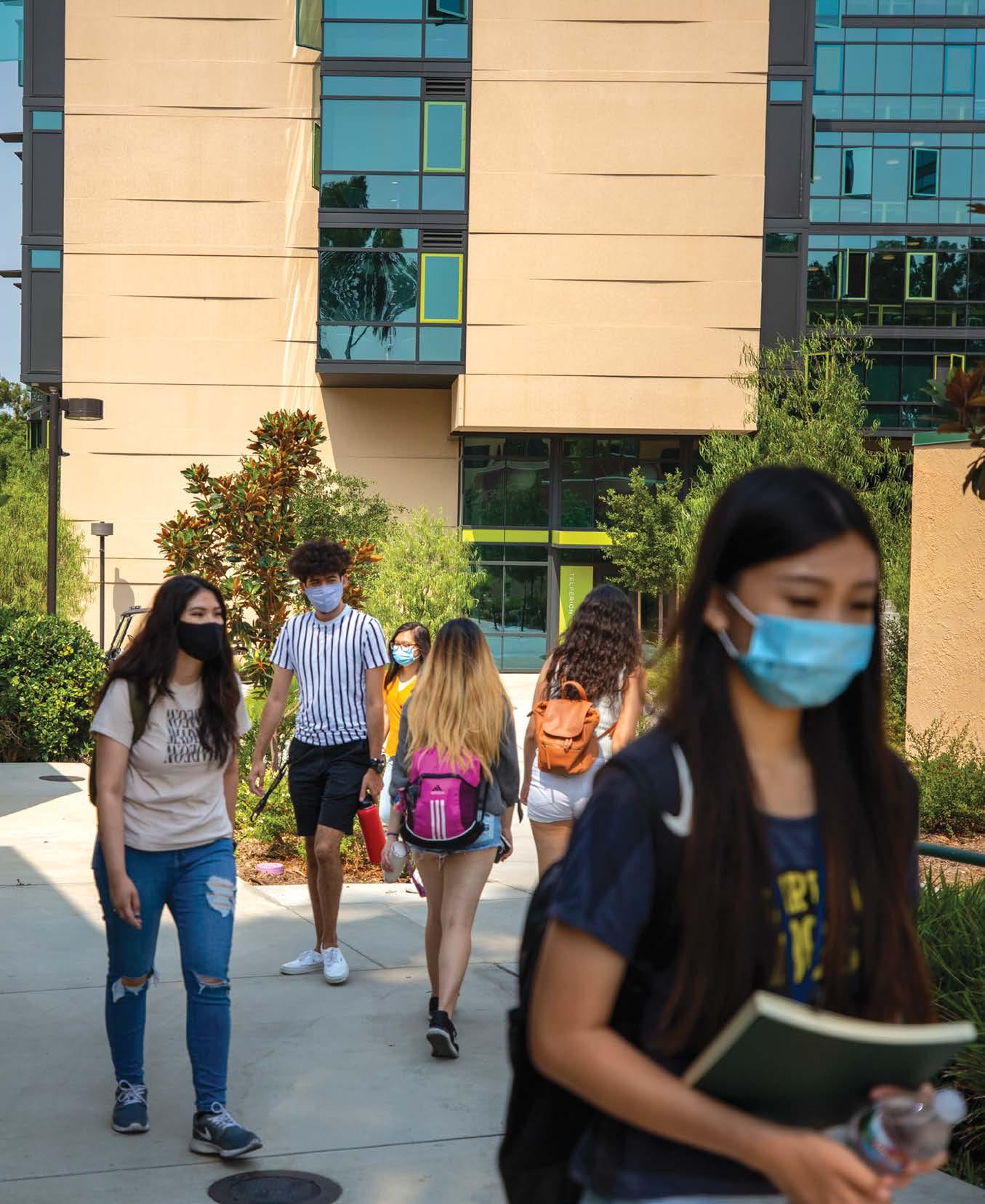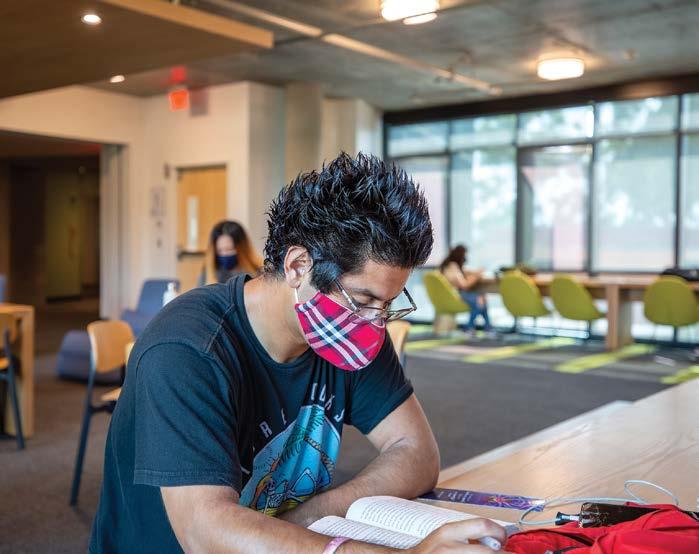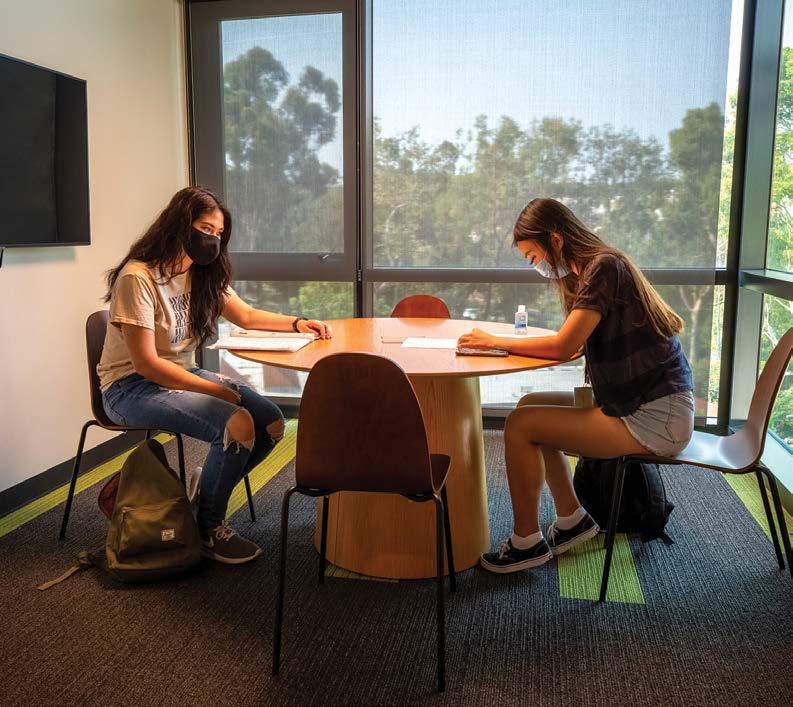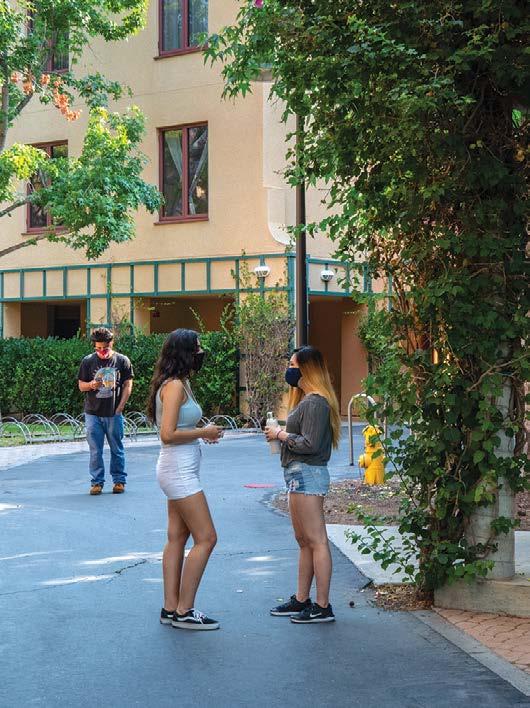
10 minute read
Learned Lessons
UCI academic leaders and students share key takeaways from an unprecedented year
/By Rosemary McClure / Photos by Corey Tull
Advertisement
Few, if any, could have imagined the rollercoaster that followed the outbreak of COVID-19 last year. The pandemic claimed millions of lives globally and gave rise to devastating economic and social disruptions. At UCI, it spawned rapid change that rocked the institution into a “new normal,” causing the greatest challenge the university has faced in its 56-year history.
But there are bright spots on the horizon. “What we learned … will set the foundation for the years ahead,” said Chancellor Howard Gillman in a note to the campus community in April 2021, and will result in “a better experience for our employees, students and patients.”
What’s next at UCI in a post-pandemic world? Academic leaders and students summarize the hardships of 2020 and – building on the university’s long tradition of innovation – discuss key takeaways from the past year and predict beneficial changes to come.
2020 Reflections: Making the Best of It
As the virus spread in 2020, the university was forced to suspend nearly all on-campus activities. The colossal task of mobilizing the organization required decisive leadership, rapid action and incredible teamwork.
“With extraordinary speed, we moved from in-person instruction to remote learning,” said Gillman as the transition was taking place last spring. “Our students packed up their lives and moved to their permanent residences. Our faculty embraced the new teaching technology and adapted to altered research conditions. And with the utmost professionalism, our staff helped enable all these changes.” Meanwhile, at UCI Medical Center, “the men and women of UCI Health worked tirelessly and selflessly to care for our neighbors and friends across the whole region,” he added.
On campus, three administrators assumed responsibility for providing access to classes, labs and research opportunities: Michael Dennin, dean of UCI’s Division of Undergraduate Education and vice provost for teaching and learning; Gillian Hayes, dean of the Graduate Division and vice provost for graduate education; and Pramod Khargonekar, vice chancellor for research and Distinguished Professor of electrical engineering & computer science.
Everything needed to be done at full throttle. “There were two weeks in which the parameters we were working under changed every 24 hours as new information about the virus emerged,” Dennin recalls. In the 10th week of the winter quarter, it became clear that spring classes would have to go fully online.
Fortunately, spring break offered faculty a chance to record lectures. Those more experienced in remote instruction helped out those with less experience, Dennin says, adding that the pandemic afforded opportunities for growth.
“For faculty, it spurred a reassessment of course curricula,” he says. “The first recorded lectures remained fairly close to the in-person experience. Then, as the comfort level with the technology rose, instructors began tweaking their delivery to make the best use of online platforms.”
There were additional challenges for UCI’s 6,500 graduate students, Hayes notes. Closed labs and canceled fieldwork disrupted research and delayed timetables for finishing experiments and dissertations.
“Students were pulled out of research sites in Africa or Europe or wherever. If they were doing fieldwork here, they often had to be pulled back as well,” Hayes says. “And, of course, if they were in a wet lab or needed access to an MRI machine or other physical resources, their research was put on hold – unless it was deemed essential.”
Some were able to pivot. Prior to the pandemic, Jazette Johnson, a third-year Ph.D. student in the Donald Bren School of Information & Computer Sciences, was designing social support technologies for people with dementia and volunteering in person with Alzheimer’s Orange County.
“Once the lockdown happened, my research took a turn,” Johnson says. Instead of focusing on ways to aid groups using virtual reality and other complex technologies, she began “to think about ways we can improve the experiences of support groups online.” To do so, she began studying a Facebook support group being run by Alzheimer’s Orange County – “a place where caregivers can post things to receive or provide various forms of social support.” Her research may have been stalled, Johnson says, if she had not already been working with that organization.
It was one of thousands of solutions that UCI faculty, staff and students struggled to find to confront the crisis.
In the early days of the pandemic, Douglas M. Haynes, vice chancellor for equity, diversity & inclusion, worried about employing stopgap measures. “How do we maintain our mission when people are not physically on campus? How do we maintain our commitment to inclusive excellence? Can we actually teach on a remote platform?” he asks rhetorically. “The faculty had been very skeptical up to that point about fully embracing alternatives to on-campus teaching.
“I want to give my colleagues and the career staff credit,” Haynes continues. “They were unsung heroes in facilitating this rapid shift. We call it a pivot, but it was a major shift within weeks. There was no plan B. Being a national leader of inclusive excellence means serving our talented students under any circumstances.”

2020-21: Shifting Priorities
Predictably, the use of online platforms mushroomed. Tom Andriola, vice chancellor for information, technology & data, says that administration of quizzes, tests and assignments through technology spurred 5,000 percent growth in internet portals.
UCI was fortunate in several ways. It was already a proven leader in cutting-edge teaching and learning strategies. More than a decade ago, pioneering work by the Division of Continuing Education had created some of the original widely available online courses. The university was also the first to equip all medical students with iPads and reinvent the curriculum for today’s healthcare via the iMedEd Initiative.
Three years ago, the campus set up “smart” classrooms in a new Anteater Learning Pavilion that paired online readings with in-class discussions and exercises. The approach, called active learning, requires students to participate, rather than passively taking notes and utilizing memorization for exams. Familiarity with this technique helped students cope with virtual instruction.


Dennin says that as faculty members adjusted to remote teaching, they began taking time to identify the core learning objectives and outcomes of their classes.
“If we’re not self-reflective at this moment and realize that all of our courses have room to improve, then I think it’s a wasted opportunity,” he says, adding that faculty who reflect on the benefits of online versus in-person classes are developing better-designed courses.
But one size doesn’t fit all. “Before the pandemic, lots of people – students and faculty – would have said that in-person learning is better,” Dennin adds. “We now have a whole suite of tools we can use. So take those tools and use the best ones, based on various criteria: the content of the class, the goal of the class, the level of the students.”
Self-reflection is also important for grad students and postdocs, who learned some painful lessons about coping with transitions during the past year, Hayes says: “It was hectic and hard, but not all were in crisis. Many were dealing pretty well, better than some faculty.” Among other silver linings, she says, they learned how to be flexible and resilient.
One of those who weathered the storm was Franceli Cibrian, a UCI postdoctoral scholar who scored a coup during the pandemic, landing a job as an assistant professor at Chapman University’s Fowler School of Engineering. But life has been a bit weird, she says.
“I moved to Orange because I was excited about teaching at Chapman – but then it turned out that I’m only online,” Cibrian says, laughing. After months of leading web-only classes, she was allowed to visit the campus to see where her class eventually would meet in person. “It was exciting,” she says. “You have to learn to appreciate the small things.”
Doctoral student Deyanira Nevarez Martinez also garnered a new job: a tenure-track position that she’ll begin in August at Michigan State University. But her prospects seemed bleak last year when the pandemic threatened to derail Nevarez Martinez’s efforts to earn a Ph.D. in urban & environmental planning & policy. Her research initially dealt mainly with Mexican border housing, but she was able to shift some of the focus to homelessness in Orange County.
“I don’t want to romanticize it because it was very challenging,” Nevarez Martinez says. “But it was an opportunity for me to be creative and still come up with something that will help individuals.”
Dean Hayes is the first to agree that the past year has caused acute pain. “Some Ph.D. students had to give up on a particular research project and move on with their lives – shift things entirely,” she says. “Others spent time analyzing data they already had. The challenge is what happens in the long haul; we won’t know the full effects for maybe five years.
“But those who have had to change their research topic have learned a lot,” Hayes continues. “As miserable as they are right now, I hope that five years from now, they’ll say: ‘Wow! I learned how to adapt when adversity was thrown at me.’”
2021: What Lies Ahead?
Everyone agrees that the university is evolving. Chancellor Gillman’s prediction: “Our next chapter will focus on the needs of our community, utilizing innovative solutions to create a UCI experience that is more satisfying, productive and supportive.
“Many of us have enjoyed the benefits of remote work … while others long for greater in-person interaction. Tomorrow will bring us the freedom to have both – virtual and physical, remote and local, digital and analog – blended in a way that advances excellence.”
COVID-19 has shown that you can have high-quality hybrid programs, Hayes notes: “In the early days of online learning, that was not necessarily true, but there has been lots of research. We know how to do it now.”
Interestingly enough, well-run, online graduate-level programs are not cost-savers, she says. They can be more expensive than traditional programs, requiring additional staff. “It takes a ton of work to create videos, make the course interactive, and ensure that students feel engaged and connected,” Hayes says, “but it’s definitely well worth it.”
Among the other benefits of a hybrid program is the possibility of extending the university’s reach. If a program calls for in-person classes, the school is constrained to reaching students within about a 50-mile radius of Irvine, Hayes says: “Students in these hybrids can come from all over the country – and other countries as well – so it really opens up who we can serve.”
Dennin has a long list of positive changes he identified during the past year. A sampling: Office hours are easier for students to access when they’re online; routine course announcements can be posted online, freeing up more time in class; and campus orientation can be simplified if portions of it are online.
“‘In person’ isn’t a meaningful term anymore, but ‘on campus’ is,” Dennin says. “The faculty will be here, the students will be here, and all of that informal interaction we missed will be back.”
Despite COVID-19’s effect on the campus, interest in its programs has skyrocketed – a development that administrators hope will continue in the future. UCI received almost 134,000 applications for fall 2021, setting a record and solidifying its position as one of the most desired schools in the country.
Additionally, the Irvine campus was the top University of California choice for in-state, first-generation students for the third consecutive year, with 47 percent of its California-resident applications coming from students who will be the first in their families to attend college.
“The word is out: UCI is a place that welcomes and supports our state’s very best students, regardless of their economic circumstances, and provides them with an outstanding college experience and lifelong opportunities,” Gillman says.
Another major thrust is UCI’s Black Thriving Initiative, which is mobilizing the university to promote Black student success by increasing total enrollments and eliminating differences in undergraduate graduation and graduate degree completion rates.
During the pandemic, “the campus worked hard to reduce the substantial inequities and support its firstgen students,” Vice Chancellor Haynes says. “They responded with grit and resilience. Our students are among the most highly talented, achievement-oriented young people you’ll find anywhere.”
For all of the UCI community, the days ahead offer excitement, Gillman suggested in his April 2021 message: “Our pioneering spirit will lead us through a once-in-alifetime opportunity to craft a more meaningful, fulfilling, truly brilliant future. I look forward to sharing this adventure with you.”







